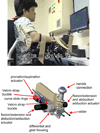Robot-aided neurorehabilitation: a robot for wrist rehabilitation
- PMID: 17894265
- PMCID: PMC2733849
- DOI: 10.1109/TNSRE.2007.903899
Robot-aided neurorehabilitation: a robot for wrist rehabilitation
Abstract
In 1991, a novel robot, MIT-MANUS, was introduced to study the potential that robots might assist in and quantify the neuro-rehabilitation of motor function. MIT-MANUS proved an excellent tool for shoulder and elbow rehabilitation in stroke patients, showing in clinical trials a reduction of impairment in movements confined to the exercised joints. This successful proof of principle as to additional targeted and intensive movement treatment prompted a test of robot training examining other limb segments. This paper focuses on a robot for wrist rehabilitation designed to provide three rotational degrees-of-freedom. The first clinical trial of the device will enroll 200 stroke survivors. Ultimately 160 stroke survivors will train with both the proximal shoulder and elbow MIT-MANUS robot, as well as with the novel distal wrist robot, in addition to 40 stroke survivor controls. So far 52 stroke patients have completed the robot training (ongoing protocol). Here, we report on the initial results on 36 of these volunteers. These results demonstrate that further improvement should be expected by adding additional training to other limb segments.
Figures








References
-
- Heart disease and stroke statistics—2003 update American Heart Association. Dallas, TX: 2003.
-
- Twitchell TE. The restoration of motor function following hemiplegia in man. Brain. 1951;vol. 74(no 4):443–480. - PubMed
-
- Jorgensen HS, Nakayama H, Raaschou HO, Vive-Larsen J, Stoier M, Olsen TS. Outcome and time course of recovery in stroke. Part I: Outcome and Part II: Time course of recovery. The Copenhagen stroke study. Arch. Phys. Med. Rehabil. 1995;vol. 76:399–412. - PubMed
-
- Nakayama H, Jorgensen HS, Raaschou HO, Olsen TS. Recovery of upper extremity function in stroke patients: The Copenhagen stroke study. Arch. Phys. Med. Rehabil. 1994;vol. 75:394–398. - PubMed
-
- Marler JR, Tilley BC, Lu M, Brott TG, Lyden PC, Grotta JC, Broderick JP, Levine SR, Frankel MP, Horowitz SH, Haley EC, Jr, Lewandowski CA, Kwiatkowski TP. Early stroke treatment associated with better outcome: The NINDS rt-PA stroke study. Neurology. 2000;vol. 55:1649–1655. - PubMed
Publication types
MeSH terms
Grants and funding
LinkOut - more resources
Full Text Sources
Other Literature Sources
Medical

